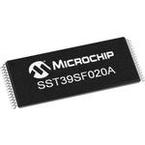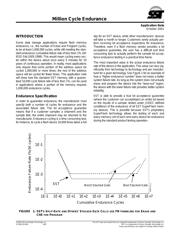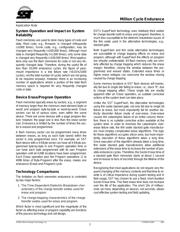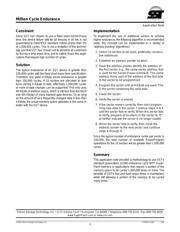下载

Application Note
October 2001
©2003 Silicon Storage Technology, Inc.
S72005-03-000 3/03
1
The SST logo and SuperFlash are registered trademarks of Silicon Storage Technology, Inc.
MPF is a trademark of Silicon Storage Technology, Inc.
These specifications are subject to change without notice.
INTRODUCTION
Some data storage applications require flash memory
endurance, i.e., the number of Erase and Program cycles,
to be at least 1,000,000 cycles, while still meeting the stan-
dard endurance cumulative failure rate of less than 1% (ref.
IEEE-Std-1005-1998). This would mean cycling every sec-
tor within the device about once every 5 minutes for 10
years of continuous operation. In reality, most applications
only require that some portion of the address space be
cycled 1,000,000 or more times; the rest of the address
space will be cycled far fewer times. This application note
will show how the standard SST memory, with a guaran-
teed 10,000 cycle failure rate of less than 1%, can be used
in applications where a portion of the memory requires
1,000,000 endurance cycles.
Endurance Specification
In order to guarantee endurance, the manufacturer must
specify both a number of cycles for endurance and the
associated failure rate. The lot acceptance guarantee
means that if a customer samples a shipment and the
sample fails, the entire shipment may be returned to the
manufacturer. Endurance cycling is a time consuming test;
for instance, to cycle a flash device 10,000 times takes a full
day for an SST device, while other manufacturers’ devices
will take a month or longer. Customers rarely actually per-
form incoming lot acceptance inspections for endurance.
Therefore, even if a flash memory vendor provides a lot
acceptance guarantee, the user has a difficult and time
consuming task to actually perform the sample lot accep-
tance endurance testing in a practical time frame.
The most important value is the actual endurance failure
rate of the device in the application. This value can vary sig-
nificantly from technology to technology and per manufac-
turer for a given technology. See Figure 1 for an example of
how a “higher endurance number” does not mean a better
system failure rate. As long as the system does not actually
erase and program the device into the “wear-out” region,
the device with the lower failure rate provides better system
reliability.
SST is able to provide a true lot acceptance guarantee
(where the customer can accept/reject an entire lot based
on the results of a sample, tested under JEDEC defined
conditions) of the endurance of all SST SuperFlash mem-
ory devices. This is possible because SST’s proprietary
SuperFlash technology allows the testing of each and
every memory cell of each and every device for endurance
during the standard product testing operation.
FIGURE 1: SST’
S SPLIT-GATE AND OTHERS’ STACKED GATE CELLS USE FN TUNNELING FOR ERASE AND
CHE
FOR PROGRAM
111E-1 1E+0 1E+1 E+2 E+3 1E+4 1E+5 1E+6 1E+7
1E-4
1E-3
1E-2
1E-1
SST
Worst Stacked Gate
Cumulative Endurance Cycles
Endurance Failure Rate (%/1K cycles)
Best Stacked Gate
.......................................................
2005 F01.1
Million Cycle Endurance
Million Cycle Endurance





